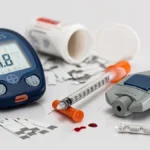Introduction: Linking Childhood Heart Health to Adult Eye Health
Maintaining good cardiovascular health from a young age may have benefits that extend far beyond the heart. Recent research shows that optimal heart health in childhood could influence the structure of tiny blood vessels in the eye during adulthood, potentially serving as an early indicator of future heart disease.

By tracking cardiovascular health from childhood into mid-adulthood, researchers have identified patterns suggesting that maintaining healthy blood pressure, cholesterol, and lifestyle habits early in life may protect microvascular structures in the retina, which are closely linked to overall cardiovascular risk. childhood heart health.
The Importance of Retinal Microvasculature
The retina contains tiny blood vessels that provide a unique window into the body’s vascular health. childhood heart health.Changes in the size, shape, or density of these vessels can indicate early signs of:
- High blood pressure
- Atherosclerosis
- Diabetes
- Increased risk of cardiovascular events
Studying these vessels allows scientists and clinicians to predict long-term health risks before symptoms appear, making early prevention possible.
Longitudinal Studies: From Childhood to Mid-Adulthood
A multi-decade study tracked 418 participants from ages 12–18 into mid-adulthood (37–43). Researchers examined:
- Cardiovascular health indicators in childhood, including blood pressure, cholesterol, body weight, and physical activity
- Retinal blood vessel structure in adulthood via eye examinations
Findings:
- Children with optimal heart health were more likely to maintain healthy retinal microvasculature as adults.
- Improvements in cardiovascular health during adolescence into adulthood correlated with better eye vessel structure.
- Poor cardiovascular health in youth increased the likelihood of retinal vessel changes associated with heart disease.
Why Childhood Matters

Health experiences in early life can have long-term consequences. Children who maintain:
- Balanced diets
- Regular physical activity
- Healthy weight
- Low exposure to tobacco or pollutants
…are more likely to have resilient microvascular systems and lower heart disease risk later in life.
Experts believe that early-life interventions can prevent or delay the onset of cardiovascular diseases decades later. childhood heart health.
Implications for Heart Disease Prediction
Retinal microvascular health may serve as a non-invasive marker for cardiovascular risk. Detecting early changes in these vessels allows:
- Identification of at-risk individuals before symptoms appear
- Tailored lifestyle and medical interventions
- Reduction in long-term cardiovascular complications
This approach emphasizes lifelong cardiovascular care, starting from childhood.
Lifestyle and Prevention Strategies
Promoting heart health in children can have lasting effects on both eye and heart health:

- Nutrition:
- Encourage fruits, vegetables, whole grains, and lean proteins
- Limit sugar and processed foods
- Physical Activity:
- At least 60 minutes of moderate-to-vigorous activity daily
- Include both aerobic and strength exercises
- Avoiding Tobacco and Pollutants:
- No smoking or exposure to secondhand smoke
- Minimize exposure to environmental toxins
- Regular Health Monitoring:
- Track blood pressure, cholesterol, and body weight
- Eye exams to monitor retinal vessels for early changes
The Role of Eye Health in Cardiovascular Screening
Routine eye exams can reveal subtle changes in microvasculature before cardiovascular symptoms emerge. Early detection allows:https://www.youtube.com/watch?v=3EXH5pe9Vno
- Personalized risk assessment
- Lifestyle modification guidance
- Potential early medical interventions
By combining eye health checks with cardiovascular assessments, healthcare providers can create a more comprehensive approach to disease prevention.
Global and Long-Term Perspectives
Chronic diseases such as heart disease often develop over decades. Studies like this highlight the importance of early prevention across diverse populations:
- Environmental exposures, diet, stress, and pollutants vary globally and can impact long-term cardiovascular and eye health
- Understanding regional differences can guide public health strategies for children
- Lifelong monitoring from childhood through adulthood is crucial for reducing disease burden
Conclusion: Lifelong Heart Health Starts Early
Optimal childhood cardiovascular health is not just about preventing immediate health issues. It lays the foundation for strong vascular and eye health in adulthood, potentially predicting and preventing heart disease. childhood heart health.

Parents, educators, and healthcare providers can:
- Promote healthy lifestyle habits from an early age
- Encourage regular physical activity and balanced nutrition
- Monitor cardiovascular and retinal health through routine check-ups
By taking a lifelong approach to heart health, children today can reduce their risk of cardiovascular complications and preserve microvascular health well into adulthood. childhood heart health.




